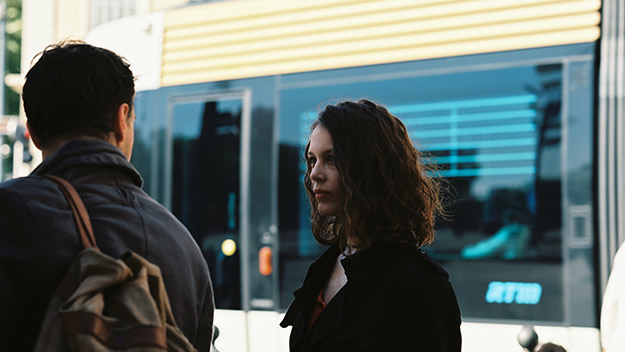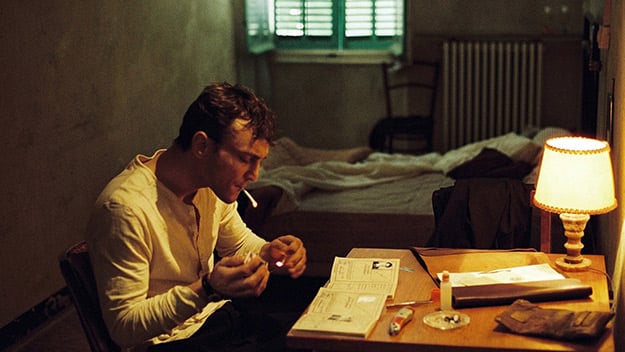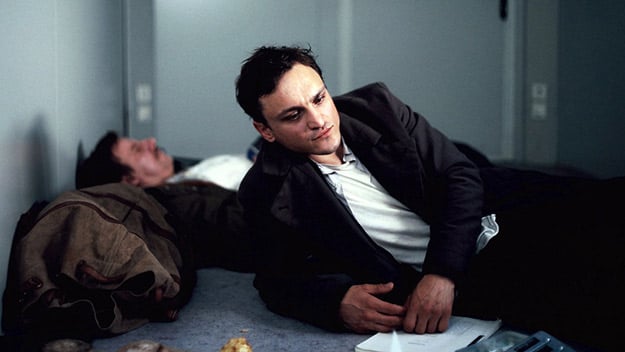Interview: Christian Petzold
The retrospective “Christian Petzold: The State We Are In” runs November 30 to December 13 at the Film Society of Lincoln Center, including a sneak preview of Transit on November 30 with Petzold in person.
For his second straight literary adaptation—and third consecutive period piece—German director Christian Petzold has brought the past to bear on the present through a simple but striking conceptual conceit. Transit relocates Anna Seghers’s eponymous 1942 novel—concerning a German concentration camp survivor seeking safe passage to North America via Nazi-occupied France—to present-day Marseille. In so doing, Petzold grants his latest feature a temporal fluidity that most historical dramas are reduced to couching, at best, in metaphorical terms.
In Petzold’s adaptation, which screened in competition at the 68th Berlinale, a Jewish audio technician named Georg (Franz Rogowski) assumes the identity of a recently deceased communist author after accepting a job to deliver his personal effects to the Mexican Consulate in Marseille. Though still set during World War II, Transit draws plain but potent parallels with the ongoing European refugee crises, not to mention the more unsettling rise of neo-Nazism. Armed with the dead author’s transit papers, Georg finds his escape plan getting complicated when he crosses paths (and slowly falls in love) with his surrogate’s widowed wife (Paula Beer, looking uncannily like the director’s longtime muse Nina Hoss), whose mysterious dealings lead him further into a web of false identities and unrequited romance. Shooting with customary economy, Petzold takes full advantage of the story’s genre machinations, chiseling the melodramatic gestures that punctuated his previous triumph, Phoenix (2014), into a taut thriller whose incongruous narrative elements only accentuate the film’s timelessly tragic arc.
Following the film’s premiere in Berlin, Petzold sat down with Film Comment to discuss his strange history with Seghers’s novel, his conceptual approach to genre, and his relationship with Harun Farocki, his writing partner (Phoenix, Barbara, The State I Am In), to whom Transit is dedicated.

Do you remember when you first came across Anna Seghers’s novel, and when you started to think you might want to work with this material?
The Federal Republic of Germany, or West Germany as it was once called, was a decidedly anti-Communist country, and Anna Seghers was a Communist. In the German Democratic Republic—that is, in Eastern Germany—she was also the President of the Writer’s Association. When I went to school, we were only given literature written by West German authors like Günter Grass or Siegfried Lenz. We were told that Anna Seghers was a terrible writer and that she wrote very dry and very basic literature—not very sophisticated, very much grounded in gray reality. Towards the end of the ’80s, I met Harun Farocki, who first was my teacher and then became my friend, and when we talked about literature I said, “Oh, Anna Seghers, forget about her.” And he answered that I didn’t have a clue. First I felt it was something of a slight, but then he gave me the book, and I read it, and it became one of the great books in my literary life. It’s also a book that characterizes our friendship because we kept reading it together approximately once a year. In some ways, all of the screenplays that we developed together were more or less based on Transit by Anna Seghers.
There’s something that I learned or, experienced, through Anna Seghers, and that is something that is actually otherwise hard to find in both literature and in cinema. And that is love, or feelings, that arise because of work, because of manual labor, or because of someone’s particular skill. So there is an erotic connection between people because one of the two has a particular skill and is very good at doing some kind of work. That is why I wanted to have the story about Georg repairing the radio in the movie. That is very much an Anna Seghers scene, and that is also why we were so detailed about him scratching out the metal that he needed. You can see how he’s repairing it and that there is really a radio station tuned in—we see all those details. Same with the character of the child that he meets: it’s this labor, and watching Georg do these things with his hands, that allows the child to develop feelings for him, to feel that this is a friend, that it’s a father-like figure for him. And for Georg himself, it also opens the door to feelings both for the boy as well as for himself. Normally in films, love is triggered by, I don’t know, a woman wearing high heels and then there is a musical score to underline it. But here, it is the skill and the manual labor of someone that gives way and allows them to develop both trust and love.
How do you integrate these aspects of labor with the cinematic elements of melodrama?
Just as the film itself goes back into the ’40s because of Anna Seghers’s novel, I myself these past years have tried to go back in cinema: just like Fassbinder rediscovered Douglas Sirk, I also rediscovered Sirk through Fassbinder. Melodramas are basically always a drama with added music, and in Fassbinder’s case the music comes out of a jukebox, while in my case we omit the music almost completely. But to have this kind of approach where there are feelings with certain grand gestures—that allows us to also escape from the kind of TV-like realism that surrounds us. That’s the link, I believe: the things that lead us into the past and that otherwise are quite frequently lost. So in that respect I can just say that, yes, I am trying to integrate the two ideas.

As far as transposing the setting from mid-20th-century to the present day, was that simply to allow for political parallels to emerge between the two eras, or are there deeper or more personal reasons for that decision?
The transit space that is described by Anna Seghers in her book is a horizontal space, it is a geographical space, it is the space between Europe and the United States. They are in the port city, and thus the space between the land where we are and the sea we want to travel over. So this is the horizontal transit space. But I think that there is also a vertical kind of transit space, and that is time, and the stories that develop over time. And so we not just find ourselves between the United States and Europe, or between land and water, but we also find ourselves trapped in yesterday’s time and today. And so I thought, has anyone ever told something like this in cinema without turning it into a joke?
What I came up with as examples are The Long Goodbye by Robert Altman, and A Young Girl at the End of the 1960s in Brussels by Chantal Akerman. Both tell their stories in today’s world with characters that are basically from the past. In one, we’ve got the model, played by Elliott Gould, who drives a car which is from 1942 and who has a moral sense that dates back to 1942, and it is as if the promise that was made by Chandler… he looks at those promises and sees that they haven’t been realized in today’s world. And that we, in today’s world, haven’t really made any progress as compared to the past. So it’s not people from the past that are ghosts—it is we that are so much more ghost-like. And that’s comparable to the movie by Chantal Akerman: it’s about a young couple in 1967; it’s shot in today’s Brussels; they get up in the morning; they dress in a 1967 kind of clothing; they go and drive to the city; they go into the record shop and buy the record Rubber Soul by The Beatles; they go back home; they listen to the record; they have sex; and that’s basically where the film ends.
And this is what I mean with the vertical kind of transit space: people today, we quite frequently act as if we’ve actually made progress as compared to the past—we are free, we can wear whatever we want to, and we are consumers who have a choice. But actually, although we are, it’s still all just consumerism and hedonism—everything that 1967 has stood for as a promise has basically been lost in between. And at the same time, we’ve got the resurfacing of those ghosts of the past that we thought had disappeared, like nationalism, and xenophobia, and people starting to define what their own identity is and who cannot belong to that and who should be ostracized and marginalized because of that. So this is the kind of time-based transitory space, the vertical transitory space, that opened up to me through my last two films.

Are these time-based concepts, or even some of the other more conceptual designs of your previous films, something we might attribute to your relationship with Farocki? You collaborated many times over the years, but your respective films couldn’t be more different.
Harun loved narrative films a lot. But he was essentially a scientist, a scholar of images and of pictures. And, of course, when we shot Transit he had already passed away, but with Phoenix he visited me on set and when he saw that we had 80 people there doing the choreography he was thrilled by it and he said, “This is so great, I could never, ever do anything like this!” But he kept taking pictures—he shot photos all the time, beautiful pictures. So we had a division of labor between us. Harun would examine the pictures and I had the freedom to dream and to fictionalize things together with him. I always loved when he made films and movies about cinema, and about the meaning of things in cinema. In Yella, for example, there was this episode that was a piece of dialogue that was originally part of a documentary that Harun had made about negotiations in a neo-liberal environment, and I took that original dialogue that was part of his documentary and fictionalized it and had Nina Hoss repeat that dialogue in one of my scenes. He then went on to show his students in Vienna at the Film Academy both these scenes with the identical text, the identical dialogues, and the students then assumed that he was responsible for the fictionalized version and that I was the one who did the documentary version. And so, actually, the fiction and the documentary parts somehow changed place and that’s when he said, “Okay, we have achieved everything we could ever achieve.”
Do you consider these last three films as something of a trilogy? Besides all being period pieces, there are many thematic and historical parallels.
I always like to think of my work in the frame of trilogies. So these were my three period pictures, and for myself I chose the larger title: “Love in Times of Oppressive Systems.” And now I will do three fairytale stories, three films based on myths and on fairy tales. That’s next.
Jordan Cronk is a critic and programmer based in Los Angeles. He runs Acropolis Cinema, a screening series for experimental and undistributed films, and is co-director of the Locarno in Los Angeles film festival.







